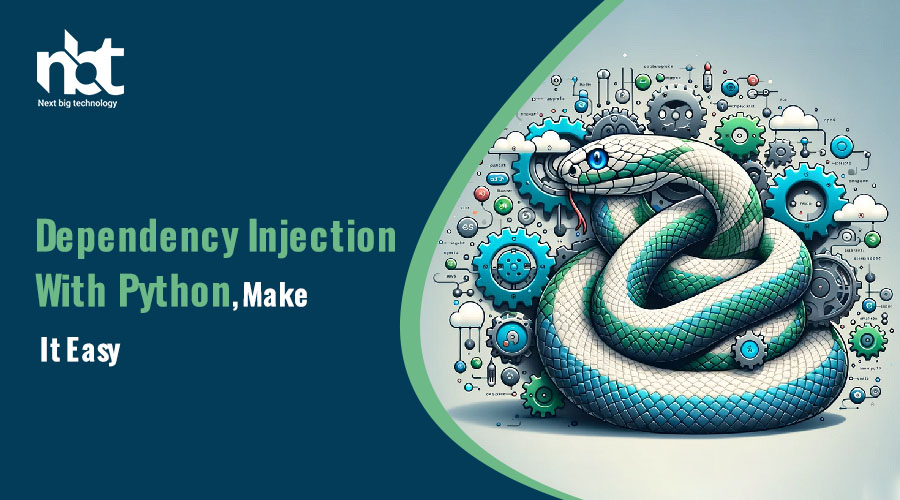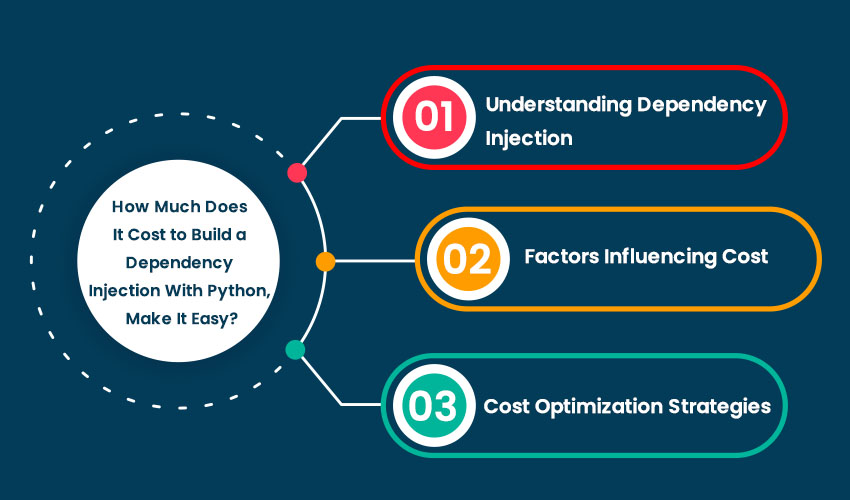Table of Contents
Dependency Injection With Python, Make It Easy Services
Dependency injection (DI) is a powerful design pattern in software development, and when coupled with Python, it becomes even more potent. In the realm of modern application development, managing services efficiently is crucial for scalability and maintainability. Thankfully, Python offers robust tools and frameworks to implement DI seamlessly, making service management a breeze.
Understanding Dependency Injection: Dependency injection is a design pattern where the dependencies of a component are injected from the outside rather than created within the component itself. This promotes loose coupling between components, making them more modular and easier to test and maintain.
Pythonic Approach to Dependency Injection: Python’s dynamic nature and flexibility make it ideal for implementing DI. There are several ways to achieve dependency injection in Python, including constructor injection, setter injection, and interface injection.
Constructor Injection: Constructor injection involves passing dependencies to a class through its constructor. This ensures that the dependencies are available when the class is instantiated, making it clear what dependencies the class requires.
Setter Injection: Setter injection, on the other hand, involves setting dependencies through setter methods. This allows for more flexibility as dependencies can be changed or updated after the class has been instantiated.
Interface Injection: Interface injection is less common in Python but involves providing dependencies through interfaces or abstract classes. This allows for even greater flexibility and decoupling between components.
Implementing Dependency Injection with Python Frameworks: While it’s possible to implement DI manually in Python, using frameworks like Flask, Django, or even third-party libraries like Flask-Injector or Injector can streamline the process. These frameworks provide built-in support for dependency injection, making service management even easier.
How to Create a Dependency Injection With Python, Make It Easy
Dependency injection is a powerful design pattern in software development, especially in Python, where it promotes flexibility, maintainability, and testability of code. However, for many developers, implementing dependency injection can be daunting. In this article, we’ll explore how to create a dependency injection framework in Python, making the process easy and intuitive.
Understanding Dependency Injection: Before diving into implementation, let’s briefly understand what dependency injection is. Dependency injection is a technique where the dependencies of a class are provided from the outside rather than being created within the class itself. This promotes loose coupling between components, making code easier to maintain and test.
Step 1: Identify Dependencies The first step in implementing dependency injection is identifying the dependencies of your classes. These dependencies can be other classes, objects, or even functions that are required for the class to perform its tasks.
Step 2: Define Interfaces (Optional) In Python, interfaces are not strictly enforced like in other languages such as Java. However, defining interfaces can still be beneficial for documenting your code and enforcing contracts between components.
Step 3: Implement Dependency Injection Container A dependency injection container is responsible for managing the dependencies of your classes and providing them when needed. We can implement a simple container using Python’s dictionaries or more advanced libraries like injector or dependency-injector.
Step 4: Configure Dependencies Once the container is in place, you need to configure it to provide the necessary dependencies to your classes. This can be done through configuration files, code, or a combination of both.
Step 5: Inject Dependencies With everything set up, you can now inject dependencies into your classes. This can be done through constructor injection, setter injection, or method injection, depending on your preference and requirements.
Step 6: Test Your Code Testing is an essential part of software development, especially when implementing a new design pattern like dependency injection. By decoupling dependencies, you can easily mock them in your tests, making it easier to isolate and verify the behavior of your classes.
Why Should You Go for Dependency Injection With Python, Make It Easy
In the realm of Python programming, efficiency and maintainability are paramount. As projects grow in complexity, managing dependencies becomes increasingly challenging. This is where Dependency Injection (DI) emerges as a powerful solution. By adopting DI, developers can streamline their codebase, enhance testability, and promote modular design. Let’s delve into why you should consider embracing Dependency Injection with Python to make your development journey smoother.
1. Decoupling Components: Dependency Injection allows you to decouple your components by removing direct dependencies between them. Instead of hardcoding dependencies within a class, you inject them from external sources. This separation enhances the flexibility and reusability of your code, making it easier to modify and maintain in the long run.
2. Enhancing Testability: Testing is an integral part of the development process, and Dependency Injection significantly simplifies this aspect. By injecting dependencies, you can easily substitute real implementations with mock objects or stubs during testing. This facilitates unit testing without the need for complex setups, ensuring that each component can be thoroughly tested in isolation.
3. Promoting Modularity: Modular design is essential for building scalable and maintainable applications. Dependency Injection encourages the creation of cohesive modules that focus on specific functionalities. Each module can define its dependencies explicitly, making it easier to understand and manage the relationships between different parts of your application.
4. Facilitating Code Reusability: With Dependency Injection, components become more reusable as they are no longer tightly coupled to specific implementations. This promotes code sharing across different parts of your project or even among multiple projects. By leveraging existing components through dependency injection, you can accelerate development and minimize redundant code.
5. Enabling Flexible Configuration: Dependency Injection allows you to configure your application easily by swapping dependencies at runtime. This flexibility is particularly useful when dealing with different environments such as development, testing, and production. By adjusting dependency configurations, you can seamlessly transition between environments without modifying the core logic of your application.
6. Improving Collaboration: Adopting Dependency Injection fosters better collaboration among team members. Since components are decoupled and dependencies are explicitly defined, developers can work on different parts of the codebase simultaneously with minimal conflicts. This collaborative approach enhances productivity and accelerates the development process.
Market Prospects of Dependency Injection With Python, Make It Easy, and Platforms
In the ever-evolving landscape of software development, Dependency Injection (DI) has emerged as a pivotal technique, particularly within the Python ecosystem. With its ability to enhance modularity, flexibility, and testability, DI has become indispensable for modern software projects. As businesses continue to seek efficient solutions to meet their technological demands, understanding the market prospects of Dependency Injection with Python becomes paramount.
The Rise of Dependency Injection in Python: Python’s popularity as a programming language has soared over the years, owing to its simplicity, readability, and vast community support. Dependency Injection once considered an advanced concept, has found its way into Python development due to the language’s inherent flexibility. This has led to the proliferation of DI frameworks and libraries tailored specifically for Python, such as Dagger, PyContainer, and Pinject.
Streamlining Development Across Platforms: One of the key advantages of Dependency Injection is its ability to streamline development across different platforms. Whether it’s web development, mobile app development, or data science, DI promotes code reusability and simplifies the integration of dependencies. This not only accelerates the development process but also ensures consistency and maintainability across various platforms.
Meeting the Demands of Enterprise Solutions: In the realm of enterprise solutions, where scalability and robustness are paramount, Dependency Injection shines as a fundamental architectural pattern. Python’s versatility coupled with DI enables developers to build scalable and modular applications that can seamlessly adapt to changing business requirements. This makes Python an ideal choice for developing enterprise-grade solutions across diverse industries.
Driving Innovation and Competitiveness: As businesses strive to stay ahead in today’s competitive market, innovation becomes a driving force for success. Dependency Injection empowers developers to focus on innovation by abstracting away the complexities of dependency management. This fosters a more agile development process, enabling companies to iterate rapidly and deliver cutting-edge solutions to market faster than ever before.
Harnessing the Power of Open Source Communities: The Python community stands out for its vibrant ecosystem of open-source libraries and frameworks. Dependency Injection is no exception, with numerous open-source projects actively maintained by developers worldwide. This collaborative environment not only ensures continuous improvement but also fosters knowledge sharing and best practices, further enhancing the market prospects of Dependency Injection with Python.
Essential Features of a Dependency Injection With Python, Make It Easy
In the realm of software development, Dependency Injection (DI) stands tall as a fundamental design pattern, promoting flexibility, maintainability, and testability in codebases. When coupled with Python, a language renowned for its simplicity and readability, Dependency Injection becomes even more potent, simplifying complex systems and empowering developers to create robust applications with ease. In this article, we’ll delve into the essential features of Dependency Injection with Python, elucidating how it streamlines development processes and enhances code quality.
Understanding Dependency Injection:
At its core, Dependency Injection is a design pattern that facilitates the creation of loosely coupled components within a software system. It achieves this by externalizing the dependencies of a class, allowing them to be provided from external sources rather than being hardcoded within the class itself. This decoupling not only improves the maintainability of code but also fosters reusability and testability.
Key Features of Dependency Injection in Python:
1. Inversion of Control (IoC): Dependency Injection in Python revolves around the principle of Inversion of Control (IoC). Instead of components controlling the flow of execution, control is inverted, and dependencies are injected from external sources, typically through constructors or setter methods. This inversion liberates components from the burden of managing their dependencies, promoting modularity and extensibility.
2. Constructor Injection: Constructor Injection is one of the most prevalent techniques used in Python for injecting dependencies. Through constructor injection, dependencies are passed to a class’s constructor as parameters, ensuring that they are readily available for use within the class. This promotes clarity and simplicity in code, making it easier to understand and maintain.
3. Setter Injection: Setter Injection provides an alternative approach to injecting dependencies by employing setter methods within a class. Dependencies are set through these methods after the object has been instantiated. While not as commonly used as constructor injection, setter injection can be beneficial in scenarios where optional dependencies or circular dependencies exist.
4. Interface-based Design: Dependency Injection in Python encourages interface-based design, wherein dependencies are defined by their interfaces rather than concrete implementations. This fosters flexibility and allows for seamless substitution of dependencies with alternative implementations, facilitating easier testing and maintenance.
5. Dependency Injection Containers: Dependency Injection Containers, also known as Inversion of Control containers, serve as centralized repositories for managing dependencies within an application. These containers automatically resolve and inject dependencies into classes, sparing developers from manual dependency management. Popular DI containers in Python include Django‘s built-in dependency injection framework and external libraries like Injector and PyContainer.
Advanced Features of a Dependency Injection With Python, Make It Easy
In the realm of software development, Dependency Injection (DI) stands tall as a design pattern that promotes code reusability, modularity, and testability. Python, with its versatility and rich ecosystem, offers robust tools for implementing DI effectively. While many are familiar with the basics of DI, delving into its advanced features can truly elevate your development process. Let’s explore how these advanced features make dependency injection a breeze in Python.
- Constructor Injection: Traditional DI often involves injecting dependencies through constructor parameters. In Python, leveraging constructor injection allows for seamless dependency management. By declaring dependencies explicitly in the constructor, you ensure clarity and ease of understanding within your codebase.
- Property Injection: Python’s dynamic nature enables property injection, where dependencies are set through class properties. This technique offers flexibility, particularly in scenarios where dependencies may vary based on runtime conditions. Property injection simplifies the process of swapping dependencies, enhancing code maintainability.
- Method Injection: Going beyond the conventional approaches, method injection empowers developers to inject dependencies directly into methods as arguments. This granular control over dependencies within specific methods enhances code readability and facilitates unit testing by isolating dependencies at a finer level.
- Decorator-based Injection: Python’s support for decorators opens avenues for implementing dependency injection seamlessly. Decorators can be used to annotate functions or methods, automatically injecting required dependencies during execution. This approach promotes cleaner code and enhances the separation of concerns within your application.
- Provider-based Injection: Introducing provider functions or classes enriches the DI process by encapsulating the creation logic of dependencies. Providers abstract the instantiation details, allowing for dynamic dependency resolution based on runtime conditions. This advanced feature fosters scalability and enhances the flexibility of your application architecture.
- Scope Management: Effective management of dependency scopes is crucial for maintaining application integrity. Python facilitates scope management through various techniques such as singleton scope, transient scope, and custom scopes. These mechanisms enable precise control over dependency lifecycles, optimizing resource utilization and promoting efficient memory management.
- Conditional Injection: Python’s expressive syntax enables conditional injection, where dependencies are resolved based on predefined conditions or configurations. This feature enhances the adaptability of your application, allowing it to dynamically adjust its behavior based on runtime parameters or environmental factors.
- AOP (Aspect-Oriented Programming) Integration: By integrating AOP principles with dependency injection, Python developers can address cross-cutting concerns such as logging, caching, and security seamlessly. AOP complements DI by providing a modular approach to implementing cross-cutting functionalities, thereby promoting code maintainability and reusability.
Dependency Injection With Python, Make It Easy Timelines
In the realm of software development, Dependency Injection (DI) has emerged as a powerful technique for enhancing modularity, testability, and maintainability of code. With Python being one of the most popular programming languages, understanding how to implement DI effectively can significantly streamline the development process. In this article, we’ll delve into the concept of Dependency Injection with Python, providing easy-to-follow timelines to make the learning process smooth and efficient.
Understanding Dependency Injection: Dependency Injection is a design pattern where the dependencies of a class are provided externally rather than created within the class itself. This promotes loose coupling between components, making the code more flexible and easier to maintain. In Python, DI can be achieved using various methods, including constructor injection, setter injection, and interface injection.
Step 1: Identify Dependencies The first step in implementing Dependency Injection is to identify the dependencies of your classes. These dependencies can include other objects, services, or resources that are required for the class to function properly. By clearly defining these dependencies, you can effectively decouple your code and make it more modular.
Step 2: Choose a DI Framework Python offers several DI frameworks such as PyInjector, Guice, and Dagger, which can simplify the process of managing dependencies. Choose a framework that best fits your project requirements and familiarity with the syntax.
Step 3: Implement DI in Python Once you’ve chosen a DI framework, it’s time to implement DI in your Python code. This typically involves configuring the DI container to manage the dependencies of your classes and injecting them where needed. Here’s a basic example using PyInjector.
Step 4: Testability and Scalability One of the key benefits of Dependency Injection is improved testability. By injecting dependencies, you can easily replace them with mock objects during testing, allowing you to isolate and test individual components of your codebase. Additionally, DI facilitates scalability by making it easier to introduce new dependencies or modify existing ones without having to refactor large portions of code.
How Much Does It Cost to Build a Dependency Injection With Python, Make It Easy?
Dependency injection is a crucial concept in modern software development, particularly in Python programming. It facilitates loose coupling, enhances code readability, and promotes easier testing and maintenance. However, one common question that arises among developers is: How much does it cost to implement dependency injection in Python? In this article, we’ll delve into this topic, breaking down the various factors that influence the cost and providing insights on how to streamline the process for ease and efficiency.
- Understanding Dependency Injection: Before we delve into the cost aspect, let’s briefly recap what dependency injection entails. Dependency injection is a design pattern where dependencies are provided to a class rather than the class creating them itself. This promotes flexibility and scalability within the codebase.
- Factors Influencing Cost: a. Complexity of the Project: The complexity of your project plays a significant role in determining the cost of implementing dependency injection. More complex projects may require intricate dependency management strategies, leading to higher development costs. b. Expertise and Experience: The expertise and experience of the development team involved also influence the cost. Skilled developers with ample experience in Python and dependency injection may command higher rates but can also deliver more efficient solutions. c. Integration Requirements: If your project involves integrating dependency injection into an existing codebase or with other frameworks, the cost may vary accordingly. Seamless integration often requires additional time and effort. d. Testing and Debugging: Proper testing and debugging are crucial aspects of implementing dependency injection. Allocating sufficient resources for testing ensures the reliability and stability of the application, albeit at an additional cost.
- Cost Optimization Strategies: a. Clear Project Requirements: Clearly defining project requirements and objectives helps in avoiding unnecessary complexities and reduces development costs. b. Utilize Existing Libraries: Python offers numerous libraries and frameworks for implementing dependency injection, such as Dagger, PyContainer, and Injector. Leveraging these existing resources can significantly reduce development time and costs. c. Agile Development Approach: Adopting an agile development approach allows for iterative development, enabling early detection of issues and reducing rework costs. d. Continuous Integration and Deployment (CI/CD): Implementing CI/CD pipelines streamlines the development process, automates testing, and ensures faster delivery, thereby minimizing overall costs.
How to Create a Dependency Injection With Python, Make It Easy – Team and Tech Stack
In the world of software development, Dependency Injection (DI) stands as a pivotal concept, fostering modularity, testability, and maintainability in our codebases. While its benefits are widely acknowledged, implementing DI in Python can sometimes be daunting, especially for teams navigating complex tech stacks. However, fear not! With the right approach and tools, creating a robust DI system can be both straightforward and rewarding. In this guide, we’ll delve into the art of crafting Dependency Injection in Python, making it accessible and easy to integrate into your team’s workflow and tech stack.
Understanding Dependency Injection:
Before we dive into the technicalities, let’s ensure everyone’s on the same page regarding what Dependency Injection entails. At its core, DI is a design pattern aimed at reducing the coupling between components in a system. It achieves this by allowing dependencies to be provided from external sources rather than being instantiated within the component itself. This approach enhances flexibility, scalability, and testability, as components become more modular and easier to maintain.
Choosing the Right Tools:
Python offers a plethora of frameworks and libraries to facilitate Dependency Injection. One such popular choice is ‘injector’, a lightweight yet powerful DI library. With ‘injector’, you can effortlessly manage dependencies and their lifecycles, ensuring smooth integration across your projects. Alternatively, frameworks like Flask and Django come with built-in support for DI, offering seamless integration within web applications.
Integrating DI into Your Workflow:
To ensure a smooth adoption of DI within your team, consider the following best practices:
- Documentation: Provide comprehensive documentation outlining the DI setup, including guidelines on defining dependencies, configuring the injector, and resolving dependencies in your codebase.
- Training and Knowledge Sharing: Conduct workshops or training sessions to familiarize team members with DI concepts and implementation details. Encourage knowledge sharing through code reviews and pair programming sessions.
- Gradual Adoption: Introduce DI gradually into existing projects, starting with smaller modules or components. Monitor the impact on code quality, performance, and developer productivity before scaling across the entire codebase.
- Continuous Improvement: Embrace a culture of continuous improvement by soliciting feedback from team members and actively seeking ways to enhance the DI setup over time.
Dependency Injection With Python, Make It Easy Process
Dependency injection is a powerful design pattern in Python that enhances code maintainability, scalability, and testability by decoupling dependencies. While it may seem daunting at first, mastering dependency injection can greatly streamline your development process. In this article, we’ll delve into the concept of dependency injection, its importance, and how to implement it effortlessly in Python.
Understanding Dependency Injection: Dependency injection is a software design pattern that allows the creation of loosely coupled components by externalizing their dependencies. Instead of components creating their dependencies, they are provided externally, typically through constructor injection, setter injection, or interface injection.
Why is Dependency Injection Important? Dependency injection offers numerous benefits:
- Decoupling: It reduces the tight coupling between components, making them easier to understand, maintain, and modify.
- Testability: Components can be easily tested in isolation by injecting mock or stub dependencies.
- Scalability: It facilitates the addition or modification of dependencies without modifying existing code, promoting scalability.
- Reusability: Components become more reusable as they are not tied to specific implementations of their dependencies.
Implementing Dependency Injection in Python: Let’s walk through a simple example to demonstrate dependency injection in Python.
Tips to Make Dependency Injection Easy:
- Use Dependency Injection Containers: Libraries like
injectororPyContainercan automate dependency injection, simplifying the process. - Follow Dependency Inversion Principle (DIP): Depend upon abstractions, not concretions, to promote flexibility and easier maintenance.
- Keep Dependencies Explicit: Clearly define dependencies in the constructor or method signatures to enhance code readability.
- Practice Dependency Injection from the Start: Incorporate dependency injection early in the development process to avoid refactoring later.
Next Big Technology – Your Trusted Dependency Injection With Python, Make It Easy Partner
In the ever-evolving landscape of technology, staying ahead of the curve is essential for businesses and developers alike. One such advancement that has been gaining significant traction is Dependency Injection (DI) in Python. As the next big thing in software development, DI offers a streamlined approach to managing dependencies and enhancing code flexibility. Let’s delve into why you should make it your easy partner in the realm of Python development.
Understanding Dependency Injection:
Dependency Injection is a design pattern that promotes loose coupling between components in a system by externalizing their dependencies. In simpler terms, it allows objects to be created with their dependencies supplied from the outside. This not only improves the modularity of code but also makes it easier to maintain, test, and extend.
Why Trust Dependency Injection?
- Simplified Development Process: With DI, developers can focus on building individual components without worrying about how they will be interconnected. This separation of concerns streamlines the development process and enhances code readability.
- Enhanced Testability: By decoupling dependencies, DI enables easier unit testing. Mocking dependencies becomes straightforward, allowing for comprehensive testing of individual components in isolation.
- Flexibility and Scalability: DI facilitates the swapping of dependencies at runtime, making the codebase more adaptable to changes. As the project evolves, adding or replacing components becomes a seamless task, ensuring scalability without compromising stability.
- Promotes Reusability: DI encourages the reuse of existing components across different parts of the application. This not only reduces redundancy but also fosters a modular architecture, where components can be easily shared and integrated into various projects.
- Improved Maintenance: By reducing tight coupling between modules, DI minimizes the ripple effect of changes. Modifications to one component are less likely to impact others, making maintenance and updates less error-prone and time-consuming.
Making DI Easy with Python:
Python, known for its simplicity and readability, provides an ideal environment for implementing DI. Several frameworks and libraries, such as Flask, Django, and PyInject, offer built-in support for DI, making it effortless to integrate into your projects.
- Flask: Flask, a popular web framework, supports DI through its extension ecosystem. Libraries like Flask-Injector provide seamless integration of DI capabilities, allowing developers to manage dependencies effortlessly.
- Django: While Django has a more opinionated structure compared to Flask, it still accommodates DI through third-party packages like django-injector. These extensions enable developers to leverage DI benefits within the Django framework seamlessly.
- PyInject: PyInject is a lightweight DI container specifically designed for Python. With its intuitive API, PyInject simplifies dependency management and promotes clean, modular code architecture.
Enterprise Dependency Injection With Python, Make It Easy
In the ever-evolving landscape of enterprise software development, the need for scalable and maintainable code has become paramount. One powerful technique that aids in achieving these goals is Dependency Injection (DI). In this article, we’ll delve into the world of Enterprise Dependency Injection with Python, exploring how this programming paradigm can be harnessed to simplify complex software architectures.
Understanding Dependency Injection:
Dependency Injection is a design pattern that promotes loose coupling by allowing components to depend on abstractions rather than concrete implementations. In simpler terms, it helps manage the dependencies between different modules or classes, making the code more modular, testable, and easier to maintain.
Python, being a versatile and dynamic language, provides a straightforward approach to implementing Dependency Injection, making it an excellent choice for enterprise-level applications.
Setting Up Dependency Injection in Python:
- Choose a Dependency Injection Framework: Selecting the right DI framework is crucial. Popular choices in the Python ecosystem include Dagger, Guice, and PyContainer. Evaluate each framework based on your project requirements, community support, and ease of integration.
- Define Dependencies: Identify the dependencies in your application. These could be external services, database connections, or any other components crucial for your application’s functionality.
- Inject Dependencies: Once dependencies are identified, inject them into the relevant components. This is usually done through constructor injection, setter injection, or method injection, depending on the chosen framework and the specific needs of your application.
Making Enterprise Dependency Injection Easy:
- Simplifying Configuration: With Python’s flexibility, you can create a centralized configuration module that handles the setup of your dependencies. This not only streamlines the injection process but also makes it easy to update configurations without modifying multiple parts of the codebase.
- Utilize Decorators: Python’s decorators offer a concise way to implement Dependency Injection. By creating custom decorators, you can annotate functions or methods with the required dependencies, enhancing readability and maintainability.
- Leverage Type Hinting: Take advantage of Python’s type hinting capabilities to enhance code documentation and enable better IDE support. Type hints make it clear which dependencies are expected, reducing the chances of runtime errors.
SEO Optimization: To enhance the SEO of your Python Enterprise Dependency Injection article, consider incorporating relevant keywords such as “Python DI frameworks,” “dependency injection best practices,” and “enterprise software development.” Additionally, include practical examples and case studies to demonstrate the real-world application of Dependency Injection in Python.
Top Dependency Injection With Python, Make It Easy Company
In the dynamic realm of Python development, mastering Dependency Injection (DI) is crucial for building scalable and maintainable software solutions. For Make It Easy Company, a seamless integration of DI can significantly enhance the efficiency and flexibility of their projects. In this article, we will delve into the top practices for Dependency Injection with Python, offering insights to streamline development processes for Make It Easy Company.
Understanding Dependency Injection: Dependency Injection is a design pattern that promotes loose coupling between components, making code more modular and easier to maintain. In Python, DI is particularly valuable for managing dependencies between different modules, classes, or functions.
-
-
Next Big Technology:

Hourly Rate :< $25 per Hour
Employees: 50 – 249
Focus Area
- Mobile App Development
- App Designing (UI/UX)
- Software Development
- Web Development
- AR & VR Development
- Big Data & BI
- Cloud Computing Services
- DevOps
- E-commerce Development
Industries Focus
- Art, Entertainment & Music
- Business Services
- Consumer Products
- Designing
- Education
- Financial & Payments
- Gaming
- Government
- Healthcare & Medical
- Hospitality
- Information Technology
- Legal & Compliance
- Manufacturing
- Media
-
- Constructor Injection for Clean Code: Embracing constructor injection is a clean and straightforward approach. By injecting dependencies through class constructors, the code becomes more readable and testable. Make It Easy Company developers can leverage this method to enhance code maintainability and minimize complexity.
- Property and Setter Injection for Flexibility: Property and setter injection provide flexibility by allowing dependencies to be injected after object instantiation. This is particularly useful for Make It Easy Company when dealing with optional dependencies or scenarios where certain dependencies are determined at runtime.
- Interface-Based Injection for Abstraction: Interface-based injection involves defining interfaces for dependencies, promoting abstraction and adherence to a contract. This makes it easier for Make It Easy Company teams to swap implementations without affecting the overall functionality.
- Scope Management for Efficient Resource Utilization: Efficiently managing the scope of injected dependencies is crucial. For Make It Easy Company, understanding the difference between singleton, transient, and scoped dependencies is vital for optimizing resource utilization and improving performance.
- Testing with Mock Objects: DI facilitates easier testing by allowing the injection of mock objects during the testing phase. Make It Easy Company developers can use this advantage to write comprehensive unit tests, ensuring the robustness and reliability of their code.
- Documentation for Seamless Collaboration: Proper documentation of dependencies and their injection points is essential for collaboration. Make It Easy Company teams can use tools like
Sphinxto generate documentation, ensuring that developers have clear insights into the project’s structure and dependencies.
Add Comparison Table Dependency Injection With Python, Make It Easy
In the realm of software development, managing dependencies efficiently is crucial for writing clean, maintainable code. Dependency Injection (DI) is a design pattern that aids in achieving this goal by decoupling components and facilitating code reusability. In this article, we will delve into the concept of Dependency Injection in Python and explore how it simplifies the management of dependencies compared to other approaches.
What is Dependency Injection? Dependency Injection is a software design pattern where the dependencies of a component are injected from the outside rather than being created within the component itself. This promotes loose coupling between components, making them easier to test, reuse, and maintain.
Dependency Injection in Python: Python, being a dynamically-typed and highly flexible language, provides various ways to implement Dependency Injection. Some common techniques include constructor injection, setter injection, and interface injection. Let’s explore these methods briefly:
- Constructor Injection: Constructor injection involves passing dependencies to a class through its constructor. This ensures that the dependencies are explicitly stated when the object is created, making the code more readable and easier to understand.
- Setter Injection: Setter injection involves setting the dependencies of a class through setter methods. While this approach provides more flexibility compared to constructor injection, it can make the code harder to follow due to scattered dependency assignments.
- Interface Injection: Interface injection, also known as interface-based injection, relies on interfaces or abstract classes to define the contract between components. This allows for swapping implementations easily, promoting modularity and flexibility.
Comparison Table: Dependency Injection in Python
| Technique | Description | Pros | Cons |
|---|---|---|---|
| Constructor Injection | Dependencies passed through constructor | Explicit, Easy to Understand | Cumbersome for Many Dependencies |
| Setter Injection | Dependencies set through setter methods | Flexibility | Code Can Become Less Readable |
| Interface Injection | Dependencies defined by interfaces or abstract classes | Modularity, Easy to Swap Implementations | Additional Abstraction Layer Required |
FAQs on Dependency Injection With Python, Make It Easy
Dependency Injection (DI) is a powerful concept in software development, and when used with Python, it can significantly enhance the modularity, flexibility, and testability of your code. However, many developers find themselves with a plethora of questions when it comes to implementing Dependency Injection in Python. In this article, we’ll address the most frequently asked questions to make the process easy and accessible for everyone.
- What is Dependency Injection (DI) in Python? Dependency Injection is a design pattern in Python that focuses on making code more modular and maintainable by decoupling the dependent components. In simpler terms, it’s a way to provide the required dependencies to a class or function from the outside rather than creating them within.
- Why should I use Dependency Injection in Python? Using Dependency Injection in Python promotes a more modular and testable codebase. It reduces tight coupling between components, making it easier to manage and extend your code. It also enhances code readability and maintainability, as dependencies are explicitly defined and injected.
- How do I implement Dependency Injection in Python? There are multiple ways to implement DI in Python, including constructor injection, setter injection, and method injection. You can use frameworks like Flask, Django, or third-party libraries like
injectororinjectto facilitate DI. Choose the method that aligns with your project’s requirements and coding style. - Can I implement Dependency Injection without any external libraries in Python? Yes, you can implement Dependency Injection without external libraries by using pure Python. Utilize constructor parameters or setter methods to inject dependencies directly. While using external libraries can simplify the process, it’s not mandatory.
- What are the benefits of using Dependency Injection in Python? Implementing Dependency Injection in Python provides various benefits, including improved code maintainability, testability, and flexibility. It also makes it easier to switch or upgrade dependencies without affecting the entire codebase.
- Are there any downsides to using Dependency Injection in Python?While Dependency Injection offers numerous advantages, it may introduce a learning curve for developers unfamiliar with the concept. Additionally, improper implementation can lead to overly complex code. It’s essential to strike a balance and use DI judiciously based on the project’s size and requirements.
- Is Dependency Injection suitable for small projects in Python? Dependency Injection is often associated with large and complex projects, but its benefits can be valuable in small projects too. While the overhead might seem unnecessary for simple applications, it can pay off in terms of code maintainability and scalability as the project evolves.
- How does Dependency Injection relate to unit testing in Python? Dependency Injection and unit testing go hand in hand. By injecting dependencies, you can easily substitute real implementations with mock objects during testing. This enables you to isolate components, test them independently, and ensure that each part of your code functions correctly.
- Are there any best practices for using Dependency Injection in Python? Some best practices for using Dependency Injection in Python include keeping the configuration separate, favoring constructor injection, and avoiding unnecessary complexity. Ensure that the injected dependencies adhere to the Single Responsibility Principle (SRP) and are well-defined.
- Can I use Dependency Injection with other design patterns in Python? Absolutely! Dependency Injection can complement other design patterns like the Singleton pattern or Factory pattern. Integrating these patterns can further enhance the modularity and flexibility of your Python code.
Thanks for reading our post “Dependency Injection With Python Make It Easy”. Please connect with us to learn more about the Dependency Injection.






















